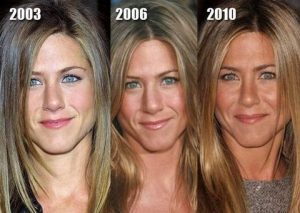Today marks the 15th birthday of the ever-popular botulinum toxin brand: Botox. Brought into the UK market in 2002 by pharmaceutical giant Allergan, the non-invasive injectable has gone from strength to strength. In the US it’s reached total sales of $21.1 billion since its launch and has grown in demand by an outstanding 797%.
Botox is quite literally changing the face of the world. To celebrate these past 15 years we bust 15 of the most common myths surrounding Botox…
1. “You should only get Botox when you have wrinkles”
Preventative Botox is very much a thing. It has been made apparent and widely supported by aesthetic practitioners in the past couple of years. Younger patients in their 20s who see lines forming on their face when they make expressions such as scowling or squinting are sometimes advised to have Botox at a younger age to relax the muscles that are causing the expressions. By stopping the face repeating these face movements we see a reduction in the build up of deep static lines and therefore fewer treatments are needed in later life.
“Prevention is better than cure.” – Desiderius Erasmus
2. “If you stop having Botox, your wrinkles will be much worse”
This is not necessarily the case. Botox injections is a non-permanent treatment lasting from 3-5 months. After this time it will begin to breakdown and dissolve. By not “topping it up” the face will go back to how it was before, with wrinkles forming from the muscle not being relaxed. This doesn’t mean you will have worse wrinkles than before your treatment!
3. “Botox is just for wrinkles”
The development of Botox and it’s uses is outstanding. Every day our inboxes are full of new Botox treatments, from “Scrotox” to migraine use. The injections are to make the muscles relaxed, which in turn can help a variety of needs in the body. At Cosmetic Courses we offer Hyperhidrosis. This uses Botox to prevent sweating under the arms by stopping the signal from your brain telling your body to sweat excessively.
4. “Only women get Botox”

Ever heard of “Brotox?” it’s the name the media has given to the male population getting Botox. It had to have a name due to the massive influx of male patients demanding this beloved treatment. We also recently uncovered “Protox”. The professional Botox taken up by lawyers and politicians alike to provide an “expressionless” face giving them an upper hand in their industry.
5. “Botox isn’t safe”
Approved in 1989 by the FDA (Food & Drug Administrative) and later approved for Cosmetic use in 2002. Botox has undergone intensive testing to be where it is today. Botox is slang for Botulinum Toxin Type A. Granted the word toxin is a bit scary to hear but the amount administered in a cosmetic procedure is so minuscule. Botox is a very safe treatment when performed by suitably qualified practitioners in a clinical environment and is enjoyed by millions of patients in the UK every year.
6. “Botox will leave my face frozen”
This is one of the most common myths we see and hear. It’s easy to search Botox and be greeted by a celebrity looking more like a doll than a human. More times then not this celebrity has not just had Botox but a combination of various treatments to get to where they are. Botox does not leave your face frozen. Facial muscles are relaxed not completely stopped so the next time you squint for the sun or raise your eyebrows you will still be able to move but the movement will be significantly lessened.
7. “People will know I have had Botox”

As with all procedures the results can be as intense as you want them to be with the guideline from a qualified practitioner. In the right clinic with the right practitioner you will leave looking a better version of yourself. Never a stranger glancing back in the mirror from too many treatments.
8. “Botox injections are painful”
The needle used to insert Botox is very fine and plenty compare it to the sensation of a tiny pinch. The treatment is also very quick only taking around 15 minutes to complete so any pain will be over in no time.
9. “Botox is permanent”
The effects of Botox last from 3-5 months. After this time it will begin to dissolve and disintegrate within the skin. “Top-ups” can be administered 12 weeks post-treatment to keep up with the desired look.
10. “Botox and filler are the same”
It’s easy to think these injections carry the same qualities, but this is wrong. To make it simpler to understand:
- Botox is for dynamic lines, the lines that appear on your face when you pull expressions. The injections relax the muscle causing the lines to not appear when pulling these expressions.
- Dermal fillers are for static lines, areas that are apparent when the face is still i.e. nose to mouth lines or mouth to chin lines. They are also used to re-introduce volume, something Botox does not achieve which is why we commonly use dermal fillers for lip augmentation and cheek re-volumisation.
11. “You don’t have to be medically qualified to inject Botox”
This is in fact true. However, Botox is a medical procedure and therefore we always recommend that if you are considering Botox you go to someone who is medically qualified and has completed the relevant aesthetic training. Although Botox is an extremely safe procedure if something were to go wrong, a medical practitioner would be able to quickly resolve the situation.
If you want to make sure your practitioner is medically qualified you can look online at the following sites:
Nurses: https://www.nmc.org.uk/registration/search-the-register/
Doctors: http://www.gmc-uk.org/doctors/register/LRMP.asp
Dentists: https://www.gdc-uk.org/
12. “A face cream can do the same job as Botox”
It’s an easy marketing tool to say “just like Botox” or “better than Botox” on a face cream. The thought of just applying a cream instead of having an injection is comforting to some. While we do promote a good skin care routine to go alongside your procedures, we are also honest in the fact that no cream can do what Botox does which is temporarily relax your facial muscles. A combination of both a high quality skincare regime and Botox injections can provide fantastic results.
13. “Botox is expensive”
The average high street price for Botox is £350 for 3 areas. It’s tempting to look for the cheapest clinic around but be careful of low prices. Ask your practitioner:
- Why is the price so much lower than your competitors?
- Is the procedure in a clinical environment?
- Are they suitably qualified?
- Are they actually using Botox or another brand?
The only occasions when a lower price may be safe is in a training environment. If you are a model for an aesthetic training company the prices are normally a third cheaper than high street costs. But being a model doesn’t mean the quality of your treatment is compromised. As long as the training company has expert trainers, uses genuine Botox, treats you in a clinical environment and offers you aftercare and reviews following your treatment then you are likely to be receiving excellent value for money.
14. “Botox is addictive”
There is no drug within the injections that is addictive to patients, so this cannot happen. The only thing “addictive” is the feeling of wanting to look young which with the right practitioner, they will monitor and never let you over do it.
15. “Botox is Botulism”
Botox is made from a purified protein taken from Botulinum Toxin. It does not carry botulism. Many medicines have been taken from toxins, the testing on these are extensive and have to pass many guidelines and regulations in order to be allowed for public use. The toxin side of Botox is incredibly low. Adminstered by a professional this procedure is safe and carries great results.
Before & After Botox
[twenty20 img1=”18603″ img2=”18604″ width=”400px” offset=”0.5″]
If you are considering Botox treatment and looking for a high quality procedure without breaking the bank then having treatment with Cosmetic Courses may be the right option for you. As a Cosmetic Courses model you are treated by medically qualified professionals supervised by our expert aesthetic trainers with a combined 113 years of experience in the Cosmetic Industry.
 The merger between the two former rivals creates a new pharmaceutical ‘supercompany’ which is set to be officially the world’s largest pharmaceutical company by sales.
The merger between the two former rivals creates a new pharmaceutical ‘supercompany’ which is set to be officially the world’s largest pharmaceutical company by sales. The aesthetic industry doesn’t stand still for long. With increasing regularity, new treatments come along and grab the public imagination.
The aesthetic industry doesn’t stand still for long. With increasing regularity, new treatments come along and grab the public imagination. 






